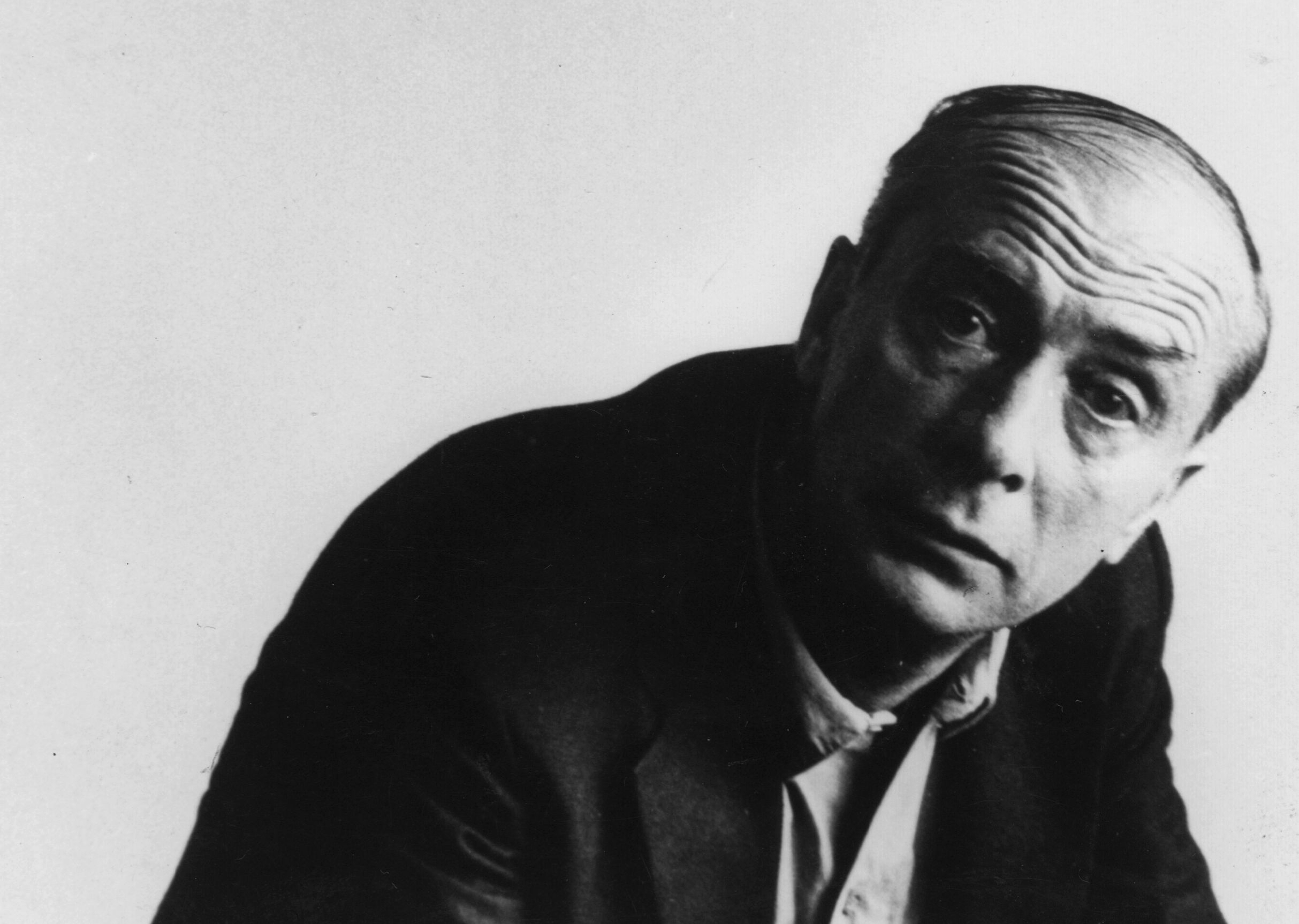WHEN I SAW MYSELF I WASN'T THERE
A BIOGRAPHY OF VINCENZO AGNETTI, by Germana Agnetti
The life and career of Vincenzo Agnetti are symbolized by his self-portrait Quando mi vidi non c’ero (When I Saw Myself I Wasn’t There). As a result, it is perhaps difficult to reconstruct it in any detail without losing something important: hence the decision to use many of the artist’s own words, even if they may sometimes seem disjointed, like a reflection in a mirror that immediately disappears.
Vincenzo Agnetti was born in Milan on 14 September 1926. He graduated at the Brera Academy and then attended the Piccolo Teatro school. There, when he was just 21, he met Bruna Soletti, the woman who would be his partner and helper for life, almost his alter ego. He started working in the field of Art Informel and poetry at a very young age, although nothing remains of this period except his account of it: “What I did, thought and heard, I’ve now forgotten by heart: this is the first authentic document.”
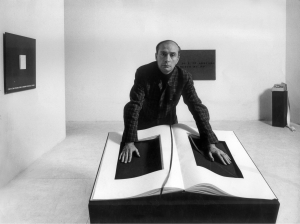
His earliest works, which seem to have been lost, fuelled the deep and meaningful career of an artist who produced most of his work over the course of just under fifteen years, from 1967 to 1981. Although these ideas, reflections, painterly and poetic actions no longer exist, they obscurely and methodically formed the course of a rich and concentrated experience that might otherwise seem to have exploded suddenly.
They are memories that stand out in the minds of those who were closest to him, in the mind of a daughter, establishing as a place of belonging. His beautiful paintings on the walls and his pottery around the house recall clips from his life stored in distant memories, transformed into places of the mind. The memory of his voice coming from the room next door, reading Proust in the evening before saying goodnight, drawing me into a mental world whose content was unknown to me as a child, but whose intonation was packed with meaning, is a part of my mind that is difficult, perhaps impossible, to describe. No visible traces remain of any of this.
“Culture is learning to forget, just like what happens when we eat. However well prepared, we soon forget the flavour of food, allowing the energy we derive from it to take over. In a certain sense we forget the flavours, poisonings and pleasures of eating by heart, moving our legs, our arms, our heads forward more freely.”
The concept of forgetting by heart represents and unites the first phase of Agnetti’s life and career. Although we can no longer see or hear him, we can appreciate this aspect of his art and life. For example all his most important emotional and work-related experiences have been forgotten by heart, but emerge as the artistic results of a hidden process.
The period he spent with just a handful of friends, including Castellani and Manzoni, with whom he shared ideals, plans and artistic aspirations, dates to the late 1950s and early 1960s. His private life was also permeated by this intellectual fervour, which was complete and structured, but had yet to show itself.
“Climbing a tree
Waiting
Waiting
Waiting
Waiting
Waiting
Waiting for leaves to grow out of our skin”
In this work too (Progetto Panteistico 2 [Pantheistic Project 2], La Foglia [The Leaf], 1972), Agnetti is awaiting the completion of the process of transformation in which thought, experiences and life become an artistic operation. Progetto Panteistico 2 is actually a piece of cultural criticism but, as is often the case, it is always open to a second interpretation in another dimension, an interpretation linked to its innermost nature, which says something about us, how we are. For Agnetti art was an operation of global synthesis and the artist, introducing a distinction between doing and being, fulfils himself in a totality in which subjectivity, consciousness and production are inextricably bound together. These were the years of his “propositional writings”, such as the preface to the Tavole di Accertamento (Works of Verification) by Piero Manzoni and Non Commettere Atti Impuri (Do Not Commit Impure Acts), published in Azimuth magazine, which already encompass elements he would develop later. His friendship with Manzoni blossomed during that period and they established an intense intellectual exchange based on personal affinities and converging lines of thought. This collaboration, also by letter when the pair were far apart, continued until Manzoni’s death.
Agnetti began his South American period in 1962. He and his family left for Argentina, where he stayed until 1967, working in the field of electronic automation. He kept in touch with his friends and the Milanese art scene by letter. Almost all of his objects and “pre-artistic” productions have disappeared, so that almost nothing remains. “I referred to that entire period as ‘liquidationism’: in the best cases ‘art-no’. ‘Art-no’ was the refusal to paint, presence at the cost of psychological crisis, the gaining of awareness through low, dull work, for true freedom; it was about heading towards new horizons.”
This was the last break immediately prior to Vincenzo Agnetti’s transformation into Agnetti the artist. His daughter remembers riding on the beach with him during that period, fishing in the rivers, sipping mate while resting in the estancias and then his notebooks, in the foreground. “During those years my father wrote incessantly whenever he had any free time. These notebooks, unlike other earlier works, still exist. He himself entitled them Absence: Two thousand pages that bring together thoughts, ideas and plans developed between one chance event and the next in South America, Scandinavia, Arabia…”
Agnetti tells us, “These objects are reminders. And yet I will never read these pages again. The texts are so precipitous and relentless that revising and editing them would take me another six years. It’s better simply to review these notebooks from a closer angle. Simply as notebooks: partitive and abstract participation. A solitary reference: a ‘here they are’ and a ‘now they’re gone’.” Reflecting on this period, Agnetti wrote that Absence is a contradiction, being both an alibi and a burgeoning awareness whose production is paradoxically hidden. In 1967, having stopped off in New York, he returned to Italy ready to start his new life and his artistic career.
Since 1967, the forgotten by heart, the hidden, as we have mentioned, became manifest art. Indeed, Agnetti’s artistic production during this new phase of his life is explained and commented upon with specific references to its structure and its genesis in a kind of personal archive or, if we like, critical reminder. Having returned to Milan, he resumed and intensified his friendship with Vanni Scheiwiller, formed in 1958 when he wrote his preface to Piero Manzoni's Tavole di Accertamento and destined to last for more than twenty years.
In 1968 he inaugurated Scheiwiller’s “Denarratori” series with his novel Obsoleto (Obsolete). The cover is by Enrico Castellani, almost sealing the intellectual and project-related partnership at the basis of Azimuth. Obsoleto has its roots in the years from 1963 to 1967 and aims to recover what had fallen into disuse and disappeared: in this sense it acts as a link between the two key phases of his life. What is more, the circular path of the narrative, the frequent use of purely graphic solutions, and the illegible pages at the end due to the filing of the lead composition by the artist himself, mark the start of reflection on language that goes beyond criticism and epistemology to enter the realm of art in a strictly conceptual sense. Just as it is impossible to separate Agnetti’s life from his artistic production from this point on, so it would also be contrived to distinguish between Agnetti the writer, Agnetti the painter, Agnetti the sculptor and Agnetti the critic. We are now faced with the “man and artist”, about whom Agnetti wrote in 1967 (Intorno alla [Around], in the book on Piero Manzoni published by Scheiwiller), where the different dimensions of criticism and artistic creativity merge to form an extraordinary singularity.
In the meantime, Agnetti departed again, firstly for Norway and then for Qatar. His absences had now become shorter and he had made a name for himself on the art scene, as demonstrated by his uninterrupted work and his letters to his friend Scheiwiller, who published them as a posthumous tribute in 1981. His artistic and literary partnership with Scheiwiller was very intense during this period. In fact, Ciclostile 1 (Cyclostyle 1) dates to 1970. This list of projects and ideas developed by Agnetti was published by Scheiwiller almost clandestinely. It was also during the early 1970s that he produced his writings on artists such as Fausto Melotti, Antonio Calderara, Raimond Girke, Reimer Jochims, Karl Pranti, Mauro Reggiani, published by Scheiwiller in Ricerca contemporanea 1, 2, 3.
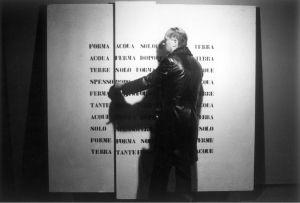
In 1967 he held his first solo show at the Palazzo dei Diamanti in Ferrara, where he exhibited an exchangeable logic entitled Principia. This work refers to a discussion on language developed in Obsoleto and it visually conveys the problem of the relativity of meanings in language. It is a large white-painted wooden panel with words written on it. A cursor that slides horizontally is secured to the panel, featuring the repetition of some words also written on the panel. Moving the cursor changes the relationship between the words, thus illustrating the concept expressed in his Tesi (Thesis), self-published in 1968: that one word is worth another, but all tend towards ambiguity. Agnetti’s works should be interpreted on two levels: the work that speaks for itself, through the power of its visual being with its underlying inner meaning, and the critical-epistemological, pointed and methodical work upon which it is based. In 1968, the year of the student protests, he exhibited his Macchina Drogata (Drugged Machine) at the Galleria Visualità, in a very evocative setting. It comprised a Divisumma 14 Olivetti calculator, whose 110 numbers were replaced with as many letters from the alphabet, so that all the words generated by the operations, even if completely meaningless, nevertheless lent themselves to a certain intonation. Exhibition visitors were led into a narrow space dominated by three large panels printed with the text from the Macchina Drogata in the cubicle, closed off by a black curtain, where it was fully operational and ready to be used by anyone who entered.
This arrangement produced a sort of ironic suspense in the visitor, who adapted well to the overturned role, from onlooker to actor, and the paradoxical logic of the operation as a whole. In this regard, Agnetti recorded in his critical reminder: “It is an operation of criticism of language. The numerical code is betrayed inasmuch as it is a code, but not destroyed because it is transformed into another language, that of the word. The very dynamic of the numerical arithmetic is deprived of its habitual meaning when it is transferred to letters.”
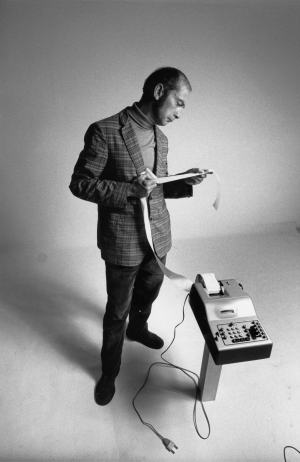
This work also conveys a kind of scepticism towards the possibility of art negating itself. In fact, the Macchina Drogata implements its betrayal and becomes a creator in its turn. The inhibited machine is used to create new works of art through its technical functions.
Another element that appears in this work is the event. The machine displayed in an exhibition produces its own exhibition with the assistance of the public: its results are extracted and hung on the wall like paintings or, better yet, like records of an artistic action. Elements of language criticism, political criticism and theatrical performance are intertwined. They are inseparable aspects of the work, which nevertheless remains an aesthetic object in its own right and an early “static theatre” piece. What is more, Agnetti takes the political discourse inherent to the Macchina Drogata to extremes and exploits it, using it to produce beautiful artworks that acquire an aesthetic impact and autonomous identity: Aritmetica (Arithmetic), Semiosi (Semiosis), Comete (Comets), Entropia (Entropy) I and II, Apocalisse (Apocalypse), Corfine, Libro quasi dimenticato a memoria (Book Almost Forgotten by Heart), etc. The drugged machine, albeit with different rhythms, continues to operate, and indeed his critical reminder reads: “The second authentic document printed is instead the work that ‘continues’.” This work that “continues” is certainly a common theme throughout Agnetti’s career, found in both his life and art.
It is true of his personal relationships, involving many women but a constant love, and his many acquaintances but few loyal friends.
It is also true of the places in his life, with his moves from Europe to the Americas and the Middle East conveying an anxious desire for change and constant development, countering his Milanese origins deeply rooted in an ongoing relationship with the city of his birth.
And it is true of his artistic production, where a single work that lasted his whole life and centred on some fundamental themes underlies the brevity of its manifestation and the variety of techniques, materials, aesthetic forms and media. Images and words form part of a single thought. At times the pause, punctuation, is achieved through images, while at others through writing itself.
Continua (Continues) is also the title of a collection of works that clearly and unequivocally refer to his intention to introduce criticism to the heart of the artistic sphere. These works were produced by photographing the pages of Domus magazine on primed canvas. These pages featured Copia da vero numero primo (Copy after the Real Prime Number), a work created in 1969 and intended to describe the evolution-involution of artistic development. By combining knowledge developed during his work in South America, he created his Neg sculpture, able to vitalize the negative (1970). “I have finally finished (developed in the Brionvega workshops) the work that I will provisionally call Neg (from negative). It is a stereo record player that allows us to listen to silence, or better, to breaks between the music. When the signal of the sound arrives from the detector (via record or tape), an inhibitor circuit blocks the signal from the amplifier and we have silence. Therefore, the breaks between the music (that is to say, the tiny interval between one sound and the next) are taken into consideration. The resonances can be cancelled by accentuating or reducing the importance of the intervals and instead of silence the inhibitor circuit sends the amplifier an adjustable white noise, taken from a low-frequency generator. In short, Neg allows us to listen to the negative of music. For example, if someone makes a speech we don’t hear it, but if the speaker is silent we hear white noise. And alongside the invention-sculpture, the patent becomes an artwork, indicating how the idea is engulfed and used by the system.
Ten years later, in 1981 in New York, he would once again take up the subject initiated with Neg when he contributed to Revolution per minute (the art record), an album produced by Jeff Gordon and composed by twenty-two artists with links to the Feldman Gallery, all names in the world of visual and conceptual art. Agnetti composed a piece in which sound is represented by pauses. The score, represented by a diagram, then became a work. Hearing was taken away, both on graph paper and on felt.
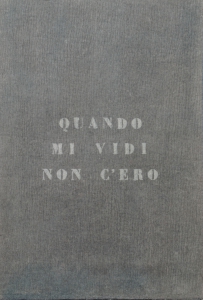
From the end of the 1960s he continued his reflection on language on several fronts. In February 1971 at the Galleria Blu in Milan he exhibited a series of felts and Bakelites that marked the start of a theme that would become extremely prolific. After working for a long time, the useful uselessness of gesture and of what is easy became inevitable in order to break up the lines for a moment: but checking was always incumbent, and soon; the break, the idea, the flavour, became the provisional support for a new discourse. The exhibition title is suggestive: “Ridondanza: paesaggi e ritratti Analisi: assiomi…” (“Redundancy: Landscapes and Portraits. Analysis: axioms…”)
His Felts are fire-branded or painted panels that feature portraits and landscapes involving the use of literary redundancy, while his Axioms are engraved Bakelite sheets painted with watercolours or treated with nitre in which diagrams and phrases express sometimes axiomatic propositions, more often tautologies, contradictions and paradoxes, countering the Felts in terms of mental coldness and conceptual rigour. An exception is Profezia (Prophecy, 1970, which is a hypothetical axiom, the only one of its kind, in which the material and the use of colour soften the aesthetic impact. “The Axioms are the counterproof of what is expressed in some of my earlier works based on the relativity of the written language… The Axioms substantially represent an exaggerated seriousness, although at times the fiction fails due to the mental processing involved.” In this sense, they are a sort of echo of Agnetti’s conceptual work and because of this they form a mental score of his career. In 1972 he exhibited his Telegrammi (Telegrams) at the Galleria Martano 2, another aspect of his reflection on language: fourteen propositions on portable language, the word transmitted, received and made into a go-between due an exemplification of anti-time, together with anti-moments; time that does not pass. “Fourteen telegrams that I sent to myself to move away from the concept of time as a state unto itself. In fact, time is nothing more than forming and consuming things. There is a passing and spending in everything that we call time.”
Therefore, this work is a discourse without temporal poetics, it is a “no-time” where departure and arrival are the same thing. With Off Limits in 1969, XIV-XX Secolo (14th‒20th Century) in 1970 and 1870‒1974 in 1974, Agnetti worked on old paintings and frescoes owned by some of his collectors, producing pieces that encompass the work of two artists in a certain period of time, and permit lucid and stark comparisons between languages developed centuries apart. Again in 1978, he used old Japanese photographs, transforming them into artworks in which irony and poetry were the decisive factors. The discourse on time is central to his work and the explicit protagonist of many of his pieces, such as his Meridiane (Sundials) or Tempus Mentis, in which the actual time represented by the sundial that measures the journey of the sun at various times of day is compared to the abstract time of philosophical formulations. An absurd sundial in which the numbers are replaced by propositions on time is the result of an ironic and paradoxical game, where the exchange continues between words and numbers that began with the “drugged machine”.
As touched upon in Tempus Mentis, so in Tempo Azione (Time Action), a series of seven drawings exhibited in 1973 at the Annemarie Verna Galerie in Zurich, time is visualized in spatial terms but, this time, it is related to the artistic action. “I started by thinking of some works of art in particular, but more in general of all so-called ‘classical’ painting: those which I have always thought of as telling stories (tales of heroes, saints or something else). Obviously, these stories are always incomplete, and we can see this in films too: they are lacking in frames, time, space. As I reflected on this, I said to myself: it must be possible to tell a complete story. And yet the only possibility to tell a complete story was to ensure that the story was very short, made up of instances. This ‒ a very short story ‒ was the theme. Then there was the problem of developing it, which in the end was simply the final, unexpected result: so I took a sheet of paper and made some marks on it, two instances, and for me this made the story complete and no detail was missing. This marked the start of a discourse.”
According to Agnetti, “Continuing to speculate on this fact, the two points then became four or more. I said to myself: ‘very good, the story is done; now I want to invert it, I want to make it disappear’. So I took up the last figure (the ‘Given two or more instances of work there will always be a work duration containing the given instances’) that was a complete figure, I left some traces of it and underneath I wrote: ‘Work almost forgotten by heart’, then I put a blank sheet on top of it and wrote ‘Work forgotten by heart’.”
His reflections on time also include his Progetti panteistici (Pantheistic Projects), Telegrammi, the Autotelefonata (Self Phone Call) and, later the Età media di A. (Average Age of A) and Dei Mutamenti (On Change), etc. In 1972, at the Galleria Françoise Lambert in Milan he exhibited Spazio perduto e spazio costruito (Lost Space and Built Space), in which he developed the relationship between space and the passage of time with a mental lucidity that transformed it into a vibrant aesthetic operation.
In 1973 he finished working on his Progetto di un Amleto Politico (Project for a Political Hamlet), which he had started during his visit to the Middle East. “Progetto per un Amleto Politico is the title of a work I planned years ago. As a whole it belongs to the type of operation I have come to call ‘static theatre’. Static theatre understood as a performance without movement, without characters and without text.
“Oscar Wilde said we cannot avoid the future; the future of the theatre is its disappearance in favour of the spectator. In this case, in order to watch a performance, the spectator will only need the simplest things, deprived of artificial news but with plenty of potential for information. For example, simply observing an object will be sufficient for getting to the roots of the reason why that object was made. The reasons for the work (object or non-object), the location and the violence for the observer, as long as he is looking for something, will be the text: The theatre will take place in the mind of the observer.”

“My project for a political Hamlet started like this:
- Hamlet is not a doubtful man.
- Hamlet is not a calculating man.
- Hamlet only remembers monologue.
- Hamlet forgets the theatre and the character.
- Hamlet is no longer the invented Hamlet but just someone who harangues the crowd with monologue.
- The monologue becomes a meaningless speech.
- Affirmation replaces introspection while numbers replace words and become simple information supports.”
As was the case for the Macchina Drogata, the exhibition venue (Galleria Forma in Genoa and Galleria Castelli in Bergamo) was absolutely extraordinary and an integral part of the operation. The Progetto per l’Amleto Politico was presented as follows: the sculpture, an essential stage, visually captivating but empty; works all around, flags from all the countries of the world combined with texts formed by just numbers that visually convey diversity of intonation, completed by the caption that indicates the seven points of the project.
The exhibition was accompanied by the recorded sound of Agnetti’s voice. The recitation of numbers alone produced an absurd atmosphere, almost bringing the future into the present.
In the early 1970s Agnetti focused on delineating precisely, with great mental lucidity and a considerable conceptual effort, the coordinates at the basis of his artistic operation that, at the end of the decade, also almost forgotten by heart, would be revisited with a renewed poetical yearning. Those were the years of his endless discussions with friends, whom he drew enthusiastically into his projects: his keenest collectors, including Malabarba, Bertolini and Rimoldi, his gallery owner and supporter Castelli, and then Franco Toselli, Daniela Palazzoli, Pierre Restany, Gregory Battcock, Achille Bonito Oliva, Carla Pellegrini and artists close to him such as Fausto Melotti, Mario and Marisa Merz, and Alighiero Boetti. And, naturally, Bruna Soletti.
These were also the years of his partnership with Domus, designed to introduce criticism into the artistic sphere, based on his friendship with Lisa Ponti; and his anonymous contributions to Data magazine, also the result of an important link, this time with Tommaso Trini.
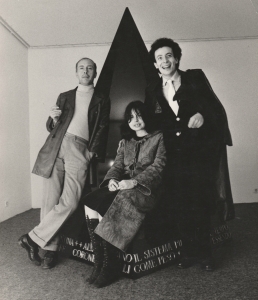
In short, artistic work was the vehicle for the meaningful relationships that revolved around his creative activity, such as his relationship with Salvatore Licitra who, at a very early age, began to frequent his studio, soon becoming his photography assistant. However, his relationships with emerging artists from the period, with whom he shared the same innovative yearning that marked many moments in his life, never led to the formation of a group. He established a few partnerships, such as the one with Gianni Colombo, with whom he produced Vobulazione e Bioeloquenza (Wobulation and Bioeloquence), or with Paolo Scheggi, with whom he designed and constructed Il Trono (The Throne), or even with Claudio Parmigiani for Lo Scriba (The Scribe), but they were always temporary. Agnetti’s art was always somewhat solitary, removed from the main trends and customs.
TRADOTTO AZZERATO PRESENTATO (translated reset presented) were the key words accompanying his political Hamlet. The theme of translation exaggerating the motto regarding one word being worth another but all tending towards ambiguity became another important common theme. On this, Agnetti wrote: “If one of us uses a language, any discipline whatsoever to produce art, soon he will find himself forced to reset the discipline itself, taking it back to the start. That will be the moment of exploiting the discipline until cancelling out its structure. The concepts will therefore be reduced to pure and simple indications: as a whole they will form a composition, in a certain sense the equivalent of the marks and colours in oil paintings.”
In this political Hamlet, for example, the resetting takes place by depriving words of their meaning and replacing them with numbers. To the extent to which the word/figure disappears, the number that replaces it becomes a simple support for intonation. The visual part recovers the impact between work and viewer, but it also declasses the illusionism at the same time. The word can no longer be objectified, as is the case in certain operations that put the word forward again as a medium in its own right. Instead, the didacticism of scholastic inspiration also fails. As a result, Hamlet’s monologue (speech) transformed into numbers reappears to us in its original form: stripped of the ambiguities of language, it offers us a work translated into all languages. This led to the appearance of Cinque oratori (Five Orators), Frammento di tavole di Dario tradotte in tutte le lingue (Fragments of Works by Darius Translated into All Languages), Architettura tradotta per tutti i popoli (Architecture Translated For All Peoples), I King (The Kings), and many more. His work was frenetic, almost as if he foresaw the shortness of his career.
In 1975 Agnetti was on the move again. Milan seemed to be constraining him, and so he looked further afield, this time heading for New York where he set up a studio in Manhattan and started working with Ronald Feldman, forming friendships with other artists, particularly Arakawa. That same year he exhibited Gli eventi precipitano (Precipitating Events) (1974) at the Galerie Sonnabend in Paris, a work comprising three sequences of six pieces each, put forward as a prototype for “equivalence”. Agnetti had already worked on the concept of equivalence, proposing a parallelism between the ambiguity of literary and mathematical language, but with Gli eventi precipitano he tackled a more global discourse on art, the artist and time that inscribes them within a certain path. “Considering that a philosophical or physical problem can be vulgarized, meaning that it can be made public in different images that reflect the same discourse, I thought about translating the route of a vector on three blackboards, representing it in the form of diagrams and areas. I then took up this discourse again on the level of familiar images, images of objects and images of people, giving place and time to a ‘didactic story’; a story of objects and people.” Indeed, Gli eventi precipitano indicates the importance of time to the path followed by things and people. The statement, represented with the Vector, unfolds at a level of blackboards and axioms, using the exaggerated seriousness and lucidity of the material and graphic medium to emphasize the mental and cognitive aspect of the operation. On the other hand, the other terms of equivalence, the object and the person, which regard art and the artist and make use of photography, respectively represent the notebooks written in South America and himself, using images to invite people to enter a biographical and poetic dimension. The Paris exhibition encompassed different aesthetics and instances in an organic fashion, but they were part of his artistic career and penetrated one another through the same discourse, summarizing the work he had done.
As it turned out, 1975 was a bridge year in which a powerful need emerged in him to make a point, to sum up the state of his art. Because of this, in his first US show at the Feldman Gallery in New York, Agnetti presented “Immagine di una mostra” (Image of an Exhibition), a show already held at the Galleria Castelli in Milan the previous year – 1974 – and also designed to focus on his artistic research. Before tracing the image of an exhibition, it is important to bear in mind the reasons for the images that will be exhibited there. Agnetti chose a selection of works for the exhibition, united by the same common thread and summed up in his written piece TRADOTTO RIDOTTO DIMENTICATO (translated reduced forgotten).
However, the works (1870‒1974, Architettura tradotta per tutti i popoli, L’età media di A, Frammento di tavola di Dario tradotta in tutte le lingue, In allegato vi trasmetto un audio tape della durata di 30 minuti [Enclosed I’m sending you a 30-minute audio tape]) also reflect other reasons, because they are connected to the multiple dimensions and different depths of his work. For example, the portrait of Angela Gallmann entitled L’Età media di A. is both paradigmatic of the multidimensionality of Agnetti’s work, and an explicit example of his ability to innovate and keep ahead of the times. In fact we have a work that, based on a critical interpretation of the history of art (past), is able to look to the future, conceptualizing and constructing a portrait that has only now been made possible by technology and digital photography.
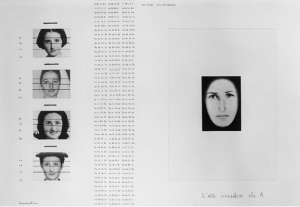
“I came up with the idea for this portrait by studying the great portrait artists of the past. What interested me in those painters – from the Sienese to Caravaggio – in Rubens’ Self-Portrait (1623), in Pollaiuolo’s Portrait of a Young Woman, to cite a few examples, is certainly not the execution of the painting itself, which strives to capture a resemblance to the sitter, but the research that, during the execution of the painting, led those artists to discover lights and tensions in the subject that are now part of the past. In short, a face painted by Rembrandt, for example, is not simply a face. It is firstly a shell, a container that magically reveals the right time, lived, enjoyed, mistaken, forgotten, of a certain person. The face is there, you see it in front of you, with all its sense of having been, of being given, understood, left. This is the only way to reconstruct in a face the key aspects developed over time that are still worth listening to. The eyes reflect a lost light that identifies a decisive moment for the portrayed subject: this is also true for today’s nose and mouth, eyes and forehead, the cheeks and so on. This is why portrait painting has captured complete characters for us, and not just mere photographs. This is why, in this work, for the Average Age of A., I chose to use several images. Carefully picked, cut out and united images. By shortening the age of A. I simply restored the right timeline to A.: her correct visual placement in time.
There is an evident discourse on time here and on the relationship between time and portrait. To paraphrase one of Agnetti’s best-known Axioms we can say that the face is the deposition of time. In this case the portrait becomes the quest for an average time of life that has already been lived, while the Identikit represents the quest for a possible future. However, this is accompanied by art criticism and the transformation of criticism into artwork. “Immagine di una mostra” is an extraordinary visiting card that immediately opened the doors for him to the art world of New York and consolidated his partnership with Ronald Feldman. His unique style was evident in New York, a hotbed of conceptual art. His work was a conceptual operation rooted in a world of poetry and philosophy originating from Europe. From then on Agnetti had two studios and two hearts, New York and Milan. He lived what could be described as a commuter existence, which was also mental, poised between two worlds, two complementary but distinct temporalities.
His artistic production continued along the lines of reflection already marked out: language, time, communication and socio-political criticism. He created static theatre pieces with a considerable emotional and visual impact, such as Elisabetta d’Inghilterra (Elizabeth of England) (1976) and works of great conceptual rigour, such as Mass Media (1977). Despite rigorously continuing his artistic research in the conceptual field, towards the end of the 1970s Agnetti’s poetic side gained the upper hand; his explanatory captions regarding the logical and cognitive register almost disappeared and his mental rigour dissolved into poetry. A great example is Il Delitto (The Crime) (1977), in which the writing that accompanies the photos translates the conceptual operation into poetry. Other examples include the large Riserva di caccia (Hunting Reserve) pieces (1978), in which the social criticism underlying the work is summed up in the phrase at the bottom: DESIRE STRIKES BEFORE THE BULLET AND SHOOTS LIKE LIGHTNING INTO THE LIMITED HEART OF THINGS. He held another show summing up his work in 1977. Agnetti felt an impelling need to make a point, to link different works around different common threads that run through them. At the Israel Museum in Jerusalem, “Mental Installation” was the title that linked a number of works produced between 1974 and 1977: Sei villaggi differenti (Six Different Villages), Elisabetta d’Inghilterra, Mass Media and Il Delitto.
In 1978 Guanda published a book of poems interspersed with pictures of his works. The title, Machiavelli 30, refers to his studio in Milan, to the place connected with his artistic life, almost an insight into the artist’s innermost heart. This is what he wrote on the back cover of Machiavelli 30: “There is a single meeting point; a single bridge of Rembrandt; a single state of aura, where art and poetry are the same thing. This happens when the punctuation and the carriage returns of poetry identify images; or when the caption of an artwork presents the images to you as punctuation.”
This equivalence enables us to identify the meeting points of Machiavelli 30: the writing that sublimates the punctuation, uncovering the images, and, on the other hand, the images that become pauses. Other explanations are unnecessary because the course of this work can only be understood by those who have already seen it in the artist’s same form and subtraction. Poetry cannot be illustrated, just as art cannot be described. A figure is not only a figure, just as a word is not only a word: in this work, figure and word together are a single thing. The inseparability of art and poetry is clearly apparent in his shows and works from this period, such as the exhibition at the Museo di Portofino (1977), where the installations created a poetical atmosphere around the conceptual operation.

First the doubt, then the poetry, the synthesis and the battle with the modern surroundings. The Della provvisorietà room illustrates this very well: a small old table with a cannonball perched on top of it, a sort of static theatre that highlights the theme of unstable balance as a fundamental aspect of our human existence. Given a table and a stone in a provisional state, between fall and falling, we have an enchanted room and a camera obscura that captures the place, the doubt, the calculation and the greeting.
The year 1980 began with sculpture, with the “Surplace” exhibition at the Galleria Toselli in Milan and the Feldman Gallery in New York. The work featured four large iron sculptures and four photographs that represent four moments of a performance in a single work, The Lost Letter, staged at the Palazzo Grassi in Venice in summer 1979. The four photographs, featuring the four crucial moments in the performance, provide the titles of the sculptures, hence the name Quattro Titoli (Four Titles). It was an intense exhibition that alluded to a literary otherness, but that also presented a strong conceptual aesthetic dimension, explicitly combining Agnetti’s two worlds: the lucid mental world of the paradox and the poetic world linked to his inner being.
Agnetti took this further in his Photo-graffie (1979‒81), which were among his last works. Poetry also invaded his style here. These works consisted of photographic paper exposed to the light and then treated and scratched so as to recover the “figurative” element, the drawing, within a conceptual operation.
This operation looks back to his works from 1974 entitled Fotografia Eseguita a Mano Libera (Free-hand Photographs) and Fotografia Eseguita ad Occhio Nudo (Naked-Eye Photographs), in which Agnetti used the interrupted processing technique to reflect on the relationship between medium and message, between tool, composition and perspective, albeit with a different end in mind.
In fact, by using an altered processing technique, Agnetti aimed to present an ironic and poetic image that anticipated and replaced the external reality with his Photo-graffie. As a result, his exhibition at the Padiglione d’Arte Contemporanea, between the end of 1980 and early 1981, featured his four large “glass pieces” entitled Le Quattro Stagioni (The Four Seasons), in which the transparent glass was “altered”, replaced by photographic paper made opaque by exposure to the light, and the external scenes are scratched drawings representing the seasons.
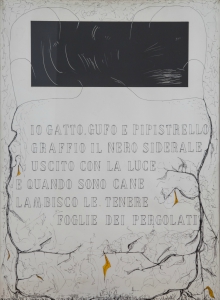
A poem accompanies this extraordinary work: I dicitori (The Reciters). Listening to his living and all-embracing voice while looking at the Vetrate Photo-graffie, we do not see people or landscapes outside us but we have insight into the incisive reality of the images of the mind and are forced to recall the verses with which Agnetti presented his last solo show in Milan at the Galleria Bruna Soletti, a few months prior to his death:
I cat owl and bat
scratch the sidereal blackness
that emerged with light
and when I am dog
I brush against the tender
leaves of the pergola
On 1 September 1981 Vincenzo Agnetti died suddenly in Milan as he was walking down the street. He suffered a brain haemorrhage, a physical and mental jolt that interrupted a career. A jolt that seems to exemplify his artistic career and recall his work: L’artista coglie solo frutti acerbi (The Artist Only Harvests Unripe Fruit) (1975).
“That same morning, very early, before I went to work, as sometimes happened given how close we lived to one another, he had spoken to me again about the Lucernario (Skylight), the large piece he was working one, which he had designed in New York and which remained unfinished.” Only fragments of this work remain today:<0} some images of how he had left it in his studio on Via Machiavelli, the cut-out photograph of the Suonatore di Fiori (Player of Flowers) and a wonderful sketch with a poem written in his own hand underneath:
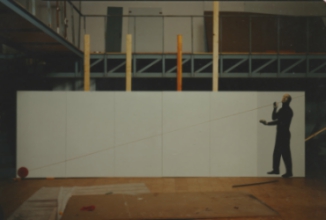
By night the Moon illuminates
an obscure Sun.
And Aureoles fly
and ignite the day.
Before the short evening
we will return to take up arms
We will be in Earth in Sun in Air.
Then with the player of flowers. Perhaps.
N.Y. 6/1981

